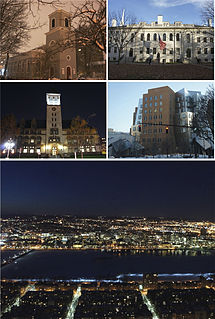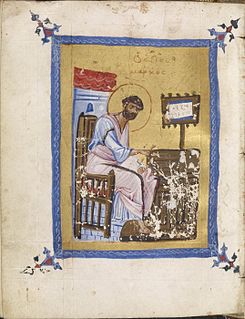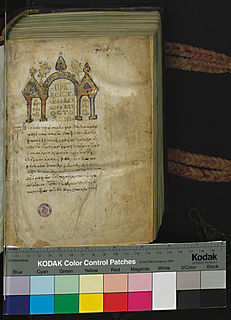| Text | Apostolarion |
|---|---|
| Date | 13th century |
| Script | Greek |
| Found | 1819 Edward Everett |
| Now at | Harvard University |
| Size | 29.5 by 23 cm |
Lectionary 172, designated by siglum ℓ172 (in the Gregory-Aland numbering) is a Greek manuscript of the New Testament, on parchment leaves. Paleographically it has been assigned to the 13th century. [1] Formerly it was labelled by 75a. [2]

A manuscript was, traditionally, any document that is written by hand -- or, once practical typewriters became available, typewritten -- as opposed to being mechanically printed or reproduced in some indirect or automated way. More recently, the term has come to be understood to further include any written, typed, or word-processed copy of an author's work, as distinguished from its rendition as a printed version of the same. Before the arrival of printing, all documents and books were manuscripts. Manuscripts are not defined by their contents, which may combine writing with mathematical calculations, maps, explanatory figures or illustrations. Manuscripts may be in book form, scrolls or in codex format. Illuminated manuscripts are enriched with pictures, border decorations, elaborately embossed initial letters or full-page illustrations. A document should be at least 75 years old to be considered a manuscript.

The New Testament is the second part of the Christian biblical canon, the first part being the Old Testament, based on the Hebrew Bible. The New Testament discusses the teachings and person of Jesus, as well as events in first-century Christianity. Christians regard both the Old and New Testaments together as sacred scripture. The New Testament has frequently accompanied the spread of Christianity around the world. It reflects and serves as a source for Christian theology and morality. Extended readings and phrases directly from the New Testament are incorporated into the various Christian liturgies. The New Testament has influenced religious, philosophical, and political movements in Christendom and left an indelible mark on literature, art, and music.

Palaeography (UK) or paleography is the study of ancient and historical handwriting. Included in the discipline is the practice of deciphering, reading, and dating historical manuscripts, and the cultural context of writing, including the methods with which writing and books were produced, and the history of scriptoria.











